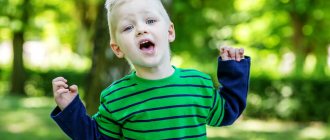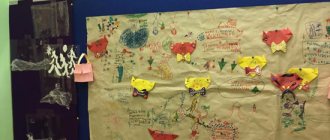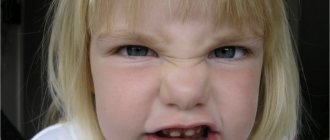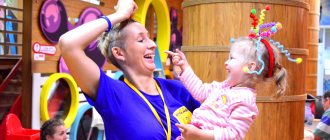1. Learn the concept of “many - little”.
2. Closer to three years - master the concept of “more-less” (determine the number of objects in a group - which ones are more and which ones are smaller).
3. Learn to distinguish between the number of objects “one” and “two”. (At a minimum. You can go further, learn to count to 3 - 4, but not all children aged 2 to 3 can do this - take into account the child’s interest and his abilities).
4.Learn to sort objects - by size, by color, by type (sort different types of pasta, buttons, large and small objects (circles, squares, etc.)), try other types of sorting.
5. Learn to navigate in space (learn the concepts of higher, lower, right, left).
6. Fold yourself, without the help of your mother, elementary puzzles or cut-out pictures from 2-3-4 parts (this skill develops gradually and becomes more developed closer to three years; at first, the mother helps the child).
7. Learn to match - play “who eats what”, “where is whose house”, “where is whose tail” (with cards or in pictures in books and manuals).
8. Play riddles - the mother describes an object or animal in the simplest form, the child guesses it from the description (for example - small, fluffy, with long white ears, jumps like that and eats carrots, who is it? Who says “moo-moo” and gives milk? Etc. Gradually you can complicate the riddles).
9. Guess the animal from the description.
10. Stack several nesting dolls and cups into each other.
11. Build a tower from cubes/cups with decreasing size values
12. Learn to compare figures, geometric bodies with their projections (Dyenesha blocks, homemade preparations)
13. Closer to three years - designing simple structures according to drawings
14. Starting from 2.5 years old - play “Fold the Square” by Nikitin (at first - together with the child, but very quickly children learn to assemble it on their own)
15. Starting from 2.5 years old – play with prefabricated puzzles
16. Learn to classify objects according to a general characteristic (for example: cards with pictures of toys, food, animals are laid out in front of the child. The child is asked to arrange them into appropriate groups (for example, toys in a box, food in a “refrigerator”, animals in a “house”). At first, the child learns to arrange objects with the active help of his mother.For the learning to be successful, it is better to play for a long time with the same set of objects (for example, to begin with, for a long time sorting cards of only toys and food).
Cards or wooden “Pick a Group” toys are great for mastering this skill:
17. Classification of objects - play the game “what’s in this room?” (find what is round in this room? What is soft in this room, etc.).
18. Games with Dienesh blocks, with a simple construction set, and other suitable items (toys, pasta, buttons, beads, etc.) by type:
– find objects, figures of the same shape;
– find objects, figures of the same color;
– find objects, figures of the same size;
– find the same figures by size, thickness and other characteristics.
19. Games with Cuisenaire sticks.
20. Play “part and whole” – “whose tail is this”, “match the roof to the house”, etc.
21. Learn to find a figure based on two signs (for example, find a large yellow circle (in a group of objects there is also a small yellow circle and circles of other colors), a small red square, etc.).
22. Closer to three years (and very individually) - find mistakes in pictures (working with manuals) - what is missing, what is wrong, which of the objects is the wrong color, etc. The very inexpensive manuals from the “Smart Books” series are great for this:
Studying the properties of objects.
1. Colors of objects.
2. Geometric figures, shapes. 3. Long-short. 4. High - low. 5. Wide-narrow. 6. Same and different (closer to three years). 7. Warm-cold. 8. Hard-soft. 9. Smooth-rough. 10. Heavy-light. 11. Taste, smell. Development of attention.
1. Play “Find it!” – we ask the child to find an object in the room (find where your teddy bear is, where the red cube is), on the street (look through the window - find where the dog is walking? Find the red car!), search in a picture in a book, etc. .P. – you can play anytime, anywhere. This game is very simple, children are easily drawn into it. At the same time, attention and the ability to concentrate it develop very well.
2. The game “Find a Pair” is a more complicated version than it was for a year or two - find a pair among objects that are very similar to each other.
3. Find the same pattern (pairs of mittens, hats, cups and saucers, patches for towels, roofs for houses, etc.)
5. Games with Dienesh blocks, Cuisenaire sticks.
6. Search for objects based on one characteristic - find what is red, hard, soft, round, large, etc. in this room. (you can play anywhere).
7. Search for objects based on two characteristics - find what is large and white, small and hard, etc. in this room.
8. Play hide and seek with the child (hide so that the baby can easily find it, prompt the child by calling him with your voice). How to develop memory.
1. “What’s missing?” - remember the pictures (toys) laid out on the table, guess which picture mom hid. Memorizing objects is carried out in a playful way - the mother tells a fairy tale about objects that are laid out on the table; during the process of the fairy tale, the child manages to remember its characters well. After this, mom takes one of them and asks “who is missing?” You can read more about how to play this game with very young children here.
2. What appeared? – we play according to the same principle as written in the previous paragraph, but we do not hide, but add toys, the child must determine which toy the mother added.
3. Hide 3-4 toys with the child. Then ask him to find them (we search from memory).
4. Ask the child to bring 2-3 items (we bring items from memory).
5. Together with the mother, remember what the child did yesterday, in the morning, some time ago, what events happened on the street (which friends were out today, what toys they had, etc.).
6. Remember what is drawn in the picture and answer questions about what was drawn there after the picture is closed.
7. Game “Find a Pair” with hide and seek – the mother shows the child a picture and hides it behind her back. Asks to find the same picture in a group of cards (the child looks for a paired picture without holding it in his hand, as usual, but from memory)
8. Game of “thimbles”. We take multi-colored cups and put a toy under one of them. We swap the cups several times, then ask them to find where the toy is hidden (we gradually increase the number of toys and cups).
9. “Memory” – a game with 2-3 cards. We put cards in front of the child, the child remembers them (to help him, you can tell a fairy tale about the heroes who are drawn in the pictures; while listening to the fairy tale, the child will remember the location of the cards well. The “fairy tale” can be very simple from 4-5 sentences). We turn the cards picture side down - this way, all the pictures are hidden from the baby and are not visible to him. We ask the child to find where a certain card is located from memory (“find which card has a bear on it?”). Another version of “Memory” can be found here. Physical development.
1. Jump in place on two legs. Closer to three years - learn to jump forward (but not everyone succeeds in this).
2. Learn to throw and catch a ball, throw a ball against a wall.
3. Throw up a balloon or ball.
4. Maintain balance while walking along a board placed on the floor, along a bench, or a beam.
5. Depict animal movements as shown by mother.
6. Crawl (like a boa constrictor, like a caterpillar) on your stomach forward.
7. Jump like a bunny.
8. Pretend to be a bird - wave your arms while running around the room, squat - “look for grains in the grass”, jump - “fly up”.
9. Stomp loudly, raising your legs high, like an elephant.
10. Swim like an octopus: lie on your back, raise your arms and legs up, wave your arms and legs (“swim”).
11. Run fast, slow, on your toes.
12. Sitting on the floor, knock on the floor with your feet, “like a drum.”
13. Roll on the floor like a bun.
14. Jump from a half-squat like a frog.
15. Dance and practice logorhythmics (to the music of the Zheleznovs and other authors).
16. Lift objects from the floor by bending or squatting.
17. Reach your arms up, reaching for objects that are located high (the mother can hold objects at the height of the child’s outstretched arm).
18. Move around the room without touching objects scattered on the floor (for example, pillows), gradually increasing the pace and number of objects.
19. Carry large, but not heavy things (for example, a highchair, a light box of toys).
20. Walking on massage surfaces.
21. Walking on tiptoes, closer to three years - on heels.
22. Perform dance movements - place the foot on the toe, on the heel.
23. Walking along a winding line drawn on the floor (or a strip of paper) - development of coordination.
24. Crawling under a tight rope.
25. Game “Catch a sunny bunny” - we play with a sunny bunny that mom lets out.
26. Collective games: dance in a circle, run like a train after each other (children hold on to each other), games with a special children’s play parachute, games of “catch up”, “wolf and bunnies”, etc.
27. "Cat and mouse." While the cat is sleeping (an imaginary cat or another adult), the children and mother walk quietly. When the cat wakes up, they quickly run into the house.
28. Hanging on the horizontal bar, rings, mother’s hands.
29. Climb on sports walls at home, on playgrounds.
30. Walking on “bumps” (chaotically scattered pillows, books).
31. Climb through a tunnel (purchased or built from chairs placed in a row).
32. Fitball games.
33. Game “Snail and House”. The child gets on all fours. A pillow is placed on his back. He turns into a snail, which carries its house (pad) on its back. The snail's task is to walk as long as possible without dropping its house (we crawl on all fours, carrying a pillow on our back).
34. Walking on your hands
Music and rhythm.
1. Listen to a lot of songs according to age.
2. Learn to listen to music - listening to classical melodies with your mother, listening to your mother’s story “What does this melody tell us?” It’s easy to come up with such a story yourself (for example, like this), with its help the child develops the ability to truly listen to music, to capture its shades and mood.
3. Learn to distinguish between fast and slow music, learn to play noise musical instruments quickly and slowly.
4. Learn to distinguish between happy and sad music.
5. Learn to distinguish between loud and quiet music, learn to play noise musical instruments loudly and quietly.
6. If there is an opportunity (large family) to play the game “who called?” (the child guesses by voice who is calling him).
7. Listen with your mother to the “sounds of life” - birds chirping, a car making noise, leaves rustling, etc.
8. Try to determine where the sound is coming from (for example, “do you hear a bird chirping? What tree do you think it’s sitting on?”).
9. Practice logorhythmics (to the music of the Zheleznovs and other authors).
10. Play musical instruments (children's and noise instruments - drum, maracas, tambourine, xylophone, etc.).
11. Get acquainted with various instruments and their sounds (you can watch videos on YouTube with your child, where performers play classical music on various instruments).
12. Closer to three years (if the child is fond of songs and remembers many melodies by ear) - play guess the melody - the mother sings the melody (“A Christmas tree was born in the forest”, “Antoshka”), the baby guesses what kind of song it is.
13. Sing songs to your child.
14. Dancing - fast, slow, stamping your feet, clapping your hands, twirling your palms - the "flashlight" movement, jumping, putting your feet on your toes - on your heels when dancing, tapping your heel on the floor, tapping your toes on the floor, doing a round dance, dancing with objects – spoons (we dance and knock spoons on the floor, against each other, over our heads, behind our backs, loudly-quietly, quickly slowly), maracas rattles (we dance and accompany ourselves, perform the same movements as with spoons), with handkerchiefs ( alone and in pairs with mom.)
15. Encourage independent performance of dance movements to dance tunes. Intensify the performance of movements accompanied by music that convey the character of the animals depicted. Drawing.
1. Draw paths.
2. Draw circles
3. Draw simple compositions - rain, snow, grass, Christmas tree decorations on the tree, circles (which will be balls, apples, etc.), draw sticks - strings for balls, stems (sticks) for flowers, handles for shoulder blades, hedgehog needles, grass, patterns (random) on cups, rugs, towels.
4. Draw vertical and horizontal lines.
5. Draw short and long lines.
6. Closer to three years - color pictures (some drawing teachers are against coloring - they believe that coloring kills creativity (since the child does not draw on his own, but works according to a ready-made template). Decide individually whether to teach your child to color or not).
7. Draw the child’s attention to the choice of color for the drawing (we draw the grass in green, the rays of the sun in yellow).
8. Draw with a stick on sand, semolina, snow.
9. Leave prints with paints using stamps and sponges.
10. Learn to paint with paints (wash and wet the brush).
11. Paint with finger paints. Modeling.
1. Roll out plasticine and dough with straight and circular movements of your hands (balls and sausages).
2. Break off small lumps from a large lump, flatten them with your palms and fingers.
3. Connect the ends of the rolled stick, pressing them tightly against each other.
4. Just play with dough and plasticine (free creativity).
5. Sculpt lumps of plasticine onto paper (feed the chicken, make dots for the ladybug, etc.).
6. Master the technique of smearing plasticine on paper.
7. Leave imprints on the dough with various objects.
8. Cut out shapes from the dough using cookie cutters.
9. Learn to cut dough with a plastic knife. Application.
1. Make a plot applique (sun + cloud + house, etc.) from 2-3 objects.
2. Apply an object of 2-3 parts (houses (roof + window), mushrooms (hat + leg), etc.).
3. Applique made of cotton wool (depict clouds, snow, dandelions, sheep, etc.).
4.Applique made from crumpled up lumps of paper.
5. Applique made from torn paper. Construction.
Build houses, fences, bridges, a slide, a garage. Play with Lego. Closer to three years - build houses according to a simple drawing (from two or three parts). Games with Dienesh blocks. Games with Cuisenaire sticks.
The world.
1. Continue studying domestic and wild animals and their young. Learn simple facts about animals (where they live, what they eat, characteristic features, for example, “a cow gives milk”, “a goat butts”, etc.), learn what domestic animals give to a person, learn the names of the main parts of an animal’s body (horns) , hooves, etc.).
2. Birds - expand your knowledge about bird species, study basic facts about birds (where they live, what they eat, how offspring appear, names of chicks). Get acquainted with the division into domestic and wild birds (simply talk about this with the child, when studying birds, emphasize that someone lives next to a person and benefits him, someone is a wild bird and lives on its own).
3. Insects – study the most common insects (ant, bee, butterfly, etc.); know the simplest facts from their life (a bee brings honey, a caterpillar gnaws on leaves, etc.), recognize them by their appearance, and cultivate a kind attitude towards insects.
Developmental activities for children 3 - 4 years old “The world around us”
Author I. Bushmeleva. Artist N. Gubareva.
At the age of 3-4 years, a child should be able to determine the time of day without difficulty.
Task for a child : Look carefully at the picture and say what the artist mixed up, what he drew incorrectly, why?
A child aged 3-4 years usually already knows that different vehicles are driven by different people. Tell him the name of the professions “machinist”, “tanker”, so that these words will enrich your child’s vocabulary.
Task for the child: Pick a pair. What kind of transport does this or that driver drive?
The child must answer your questions. It is important to present everything in the form of a game.
Assignment (questions) for the child:
1. In the morning the sun rises, and in the evening... (sets)
2. It rained, and... (puddles) appeared on the asphalt
3. Birch has leaves, and pine has... (needles)
4. In winter it often snows white, fluffy... (snow)
5. Water flows from the tap. And when it freezes, it turns into... (ice)
6. Is the ice soft or hard? (solid). Can it flow like water? (No). Is it cold or warm? (cold). Is the water cold or warm? (can be cold and warm).
A 3.5-4 year old child must distinguish animals that can live in city apartments from animals living in the countryside.
Activity with a child: look carefully which of these animals live in the village.
We teach a child to recognize a tree by its leaves. We study the names of flowers.
Task for a child : look at the leaves, from which tree did they fall (birch, maple, willow)? What are these flowers called (chamomile, rose, tulip, cornflower)?
A child of 3-4 years old, of course, already knows wild animals (from fairy tales, pictures, poems). He must be able to describe the animal and tell some of its features.
Activity with a child : There are animals in the picture, name them. Which one of them lives, where does it live, what does it like to eat, what color is its skin, which one is bigger? What are the “legs” of a wolf (paws) called? What about the elephant's nose (trunk)? Which animal has the largest neck, ears, teeth?
A child of 3-4 years old should be able to separate vegetables from fruits and voice the fact that some fruits are vegetables (grow in the garden), and others are fruits (grow on trees).
Assignment for a child: Miraculously, the tree grew fruit. Name them. Look and tell me which fruits do not grow on trees. Where do they grow?
A child aged 3-4 years already knows that there are adults and children. But what are they called correctly?
Activity with a child : Please tell me who is drawn in this picture (animals, beasts)? Please note that these are parents and their children. Do you know what they are called? (elephant (elephant) - baby elephant, bear (shema bear) - bear cub, cat (cat) - kitten, tiger (tigress) - tiger cub).
A 3.5-4 year old child should already know polite words and be able to use them correctly.
Lesson with a child: question - answer. Ask your child to answer your questions.
- In the morning you woke up and went to brush your teeth, on the way you met your mother. What will you tell her? (Good morning).
- In kindergarten, the girl Tanya treated you to an apple, and you told her... (thank you).
- You have friends? What are their names? If your friend asks you to help him, what will you do? (I'll help).
- Do you go to kindergarten? What time of day do you come to kindergarten (in the morning), and when do your parents pick you up (in the evening).
- What do you say to your family when you go to bed (good night).
- You came to visit a friend, what will you say when you see him? (Hi Hello).
- Mom asked you to help her clean the room, what will you do? (I’ll help, collect toys, etc.).
- Grandma was knitting socks for you, and her ball of yarn fell, what will you do? (I'll pick it up).
MATH GAMES
We introduce kids to the basics of counting, numbers, and the concept of more and less. If your child doesn’t count yet, you can start learning now. Count out loud the buttons on clothes while dressing, the steps on the stairs. You can play it like this:
"WE'RE SETTING THE TABLE"
The game allows you to combine two things at once - help your mother in the kitchen and learn to count. A child can prepare the required amount of cutlery, bring two carrots, three apples - tasks can be invented on the fly.
“FOLD A SQUARE” ACCORDING TO NIKITIN’S METHOD
Variations on a theme.
"BIG - MEDIUM - SMALL"
This manual can also be used as stencils and for developing spatial thinking: “What is above the triangle? And to the right of the square?
"DIENES BLOCKS"
For the development of memory, logic, imagination, spatial thinking, and the ability to compare.
A set of games for the development of logical thinking and mathematical abilities “Pythagorics”.
MATH TABLET
A manual that you can use for a very long time! The capabilities of the math tablet are so wide that it will be interesting for both 2-3 year olds and younger schoolchildren.
NIKITIN FRACTIONS
Wooden insert frames will allow your child to quickly form ideas about the component parts of an object. You can play with Nikitin Fractions for a very long time. Of course, with age it becomes more complicated, the way information is presented changes and the acquired skills improve.
KUISNER'S STICKS
A universal benefit for a wide age range! This is a construction set, a math simulator, and a mosaic! Cuisenaire sticks are a set of multi-colored sticks of different sizes, with the help of which children develop ideas about numbers, the basics of counting, and the ability to measure objects.
FIGURE CONSTRUCTOR
The game has 48 tasks and 4 difficulty levels. The principle of constructing tasks in the Shape Constructor from simple to complex is followed, and this is very important for 3-year-old children, because our task as parents is not to alienate the child with an incorrectly posed complex task.
SHY RABBIT
The set of the logic game Shy Rabbit includes wooden pieces and 60 cards with tasks of varying difficulty levels. The kid chooses a card with a task and builds the depicted structure from wooden blocks. An excellent game for developing spatial thinking.
DAY AND NIGHT
An excellent puzzle, in the company of which your child will train spatial thinking, attention, and motor skills.
The Day and Night game set includes 10 bright and colorful blocks, a base frame with three rods of different lengths, and notebooks with tasks.
Development of fine motor skills
Children of early preschool age continue to master working with small objects. They are attracted to all kinds of lacing, locks, zippers, and buttons. Constantly replenish your personal supplies with new educational games.
Finger gymnastics is another type of educational game that should be present in a child’s life. Look for new exercises in the literature and learn them with your child.
Here is one example:
We bake excellent wheat pies. (We place one palm on the other, then vice versa - we make pies). Who will come to us to try wheat pies? (Two palms side by side, depicting a tray of pies). Mom, dad, brother, sister, Shaggy dog from the yard. (We bend our fingers one by one, starting with the thumb). And others, everyone who can, Let them come with them too. (We wave our palms towards ourselves - we invite guests) We kneaded the dough, (we depict with our hands how the dough is kneaded) We did not forget the sugar. (Sprinkle a pinch of sugar) We put wheat pies in the oven. (We grab the imaginary pie with our hands and put it in the stove - forward movement) The stove burns merrily, Our mother says: - The crumbs that remain will go to the Sparrow. (We depict how a sparrow pecks crumbs - with the index finger of one hand from the palm of the other hand).
SPORT GAMES
The harmonious development of children is impossible without physical activity. It’s good if at home there is a wall bars and a horizontal bar, where the baby can work out and throw out the accumulated energy. But even this is not enough for little fidgets at this age. Daily walks outside and morning exercises are considered mandatory for them. It is necessary to warm up between games. In the summer, children’s stay in the fresh air should be maximized, combining a walk with activities useful for development.
Following the rules, losing with dignity, adhering to a given line of behavior, this is not about younger preschoolers. Children of this age category are not yet ready for such activities, therefore, in the matter of organizing interesting leisure time, they urgently need the help of adults. An alternative solution for the latter are active games.
"SEARCH FOR TOYS"
On the site, a table of 6-8 cells is drawn with chalk, in which the available toys are schematically depicted. The adult hides these toys, and the child looks for them and puts them in the appropriate cells.
"OVERCOME OBSTACLES"
An obstacle course is constructed from plastic bottles, toys, and blocks, which the child must overcome by avoiding obstacles on a bicycle or scooter.
"MONKEYS"
The kids form a circle, with an adult in the center. The task of the little dancers is to copy the movements of the leader to the music as accurately as possible.
"SLOW AND FAST"
Children learn the movements and, at the command of an adult, begin to perform them, taking into account the constantly changing pace set by the leader.
BALL GAMES
“Fetch”: To play you will need two balls of different colors, but of the same size. Having picked them up, the players stand at the pre-drawn starting line. At the command “Aport!” Everyone must throw their ball as far as possible and immediately run after the opponent’s ball. The first one to bring someone else's ball wins.
GAMES ON ORTHOPEDIC RUGS
The mats can be used as obstacle courses. You can also give different tasks to the kids, like: “stand on the pink pebbles! And now - onto the yellow cones! Gradually you can speed up the pace of the game. You can also use rugs as a version of the Twister game.
Even more interesting games here.
Spending time with adults gives a child happiness and joy.
RING BROS
This game is an interesting sporting event for both one child and a group of children; it is one of the games for active recreation, where children can captivate themselves. To complicate the task, you can increase the distance, or play for speed and time. It is also convenient that the Ring Thrower can be used both indoors and outdoors.
Physical activity
Physical education classes, warm-ups and outdoor games should be present in the children’s schedule every day. Thanks to them, they learn to control their body, strengthen their muscles, and develop dexterity. If you have the opportunity, then visit the sports section at least twice a week. Each age of a child has its own characteristics. He comprehends some types of activities easily and naturally. But individual activities do not attract his attention. Therefore, take your time to teach your child to read, write, and add syllables. He will easily master all these skills in a year or two. But if he does not learn to play, does not get the opportunity to get acquainted with the world through sensory perception, then his productive development will really be at risk.
Formation of the concept of speech designations of the right and left parts of the body, memory development.
To develop memory, you can use short poems. Don’t force your baby to memorize them, just read to him more often, and soon he will begin to finish the phrases himself .
To introduce your child to the concepts of “right” and “left”, use the version of the poem below. Movements are performed in accordance with the text.
The right hand woke up, perked up, stretched, rubbed the right ear and lay down on the right side. The left hand woke up. I perked up. She stretched, rubbed her left ear, and lay down on her left side. Right foot: Top, top, top. Left foot: Top, top, top. And with both hands: clap!
ROLE-PLAYING GAMES
By bringing dolls and animals to life, and acting out life situations, children learn to interact in a team, find solutions to assigned problems, and express their mood and interests. By influencing this area of a child’s activity, adults can discern and correct mistakes made in raising a child, instill generally accepted norms of behavior, and form the right habits and attitude towards others.
"MOTHERS AND DAUGHTERS"
Girls always want to try on the role of an adult mother who takes care of her baby, feeds her, takes her for a walk, puts her to bed.
"HOME CONSTRUCTION"
A plot that allows you to expand your child’s horizons with knowledge about construction equipment and professions. The little ones are involved in the process of creating a beautiful interior and home comfort, the boys try on the role of the head of the family.
MUSICAL GAMES
Useful and exciting activities for kids can be varied. Children especially like games for children with music. With their help, babies learn to control their movements and feel a given rhythm. At home with your child, you can simply play music and introduce him to musical instruments.
"RAIN"
The adult invites the child to reproduce the sound of rain using cubes, but clarifies that it will be either strong or small. The baby must grasp the tempo and pitch of the sound.
“WHAT INSTRUMENT DO I PLAY?”
Parents prepare musical instruments, name each one, and play the sound. Then the toy hides and plays one by one - the child guesses which instrument. You can use the following tools:
- pipe,
- whistle,
- glockenspiel.






